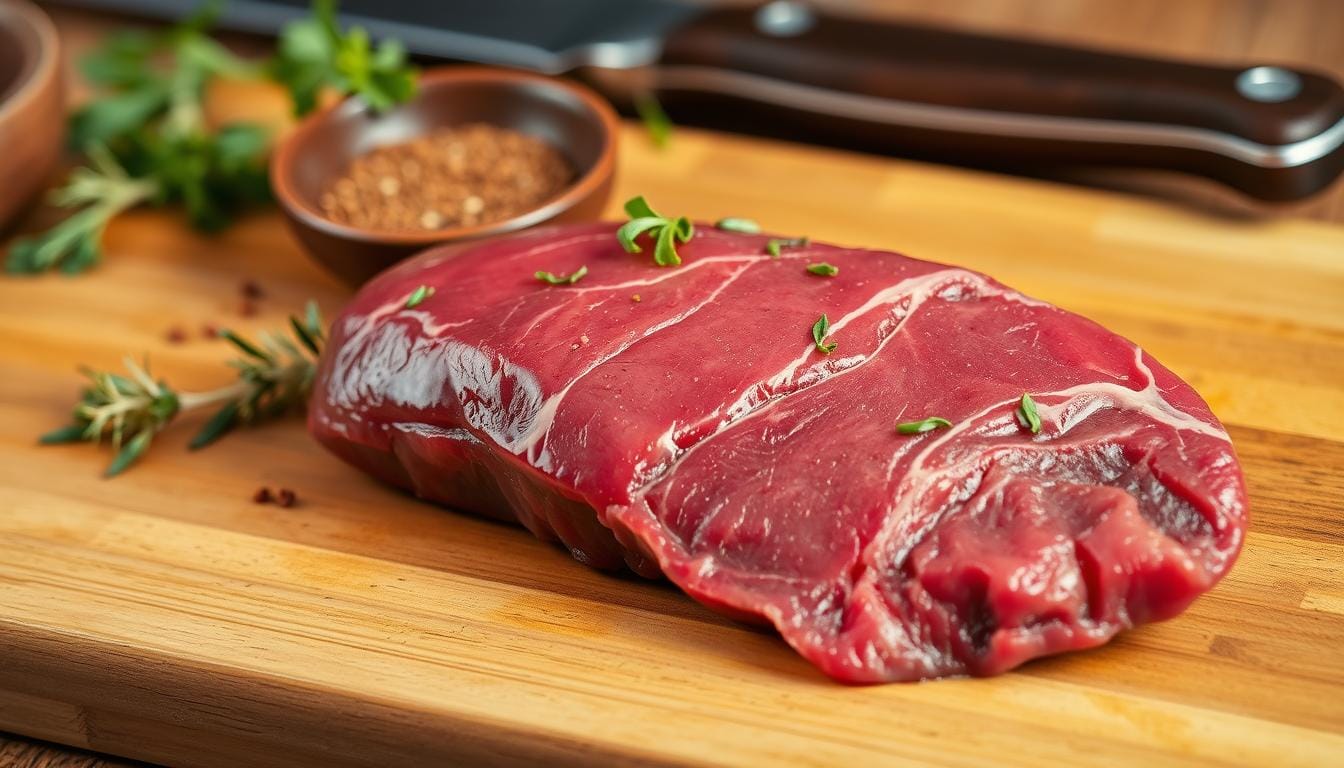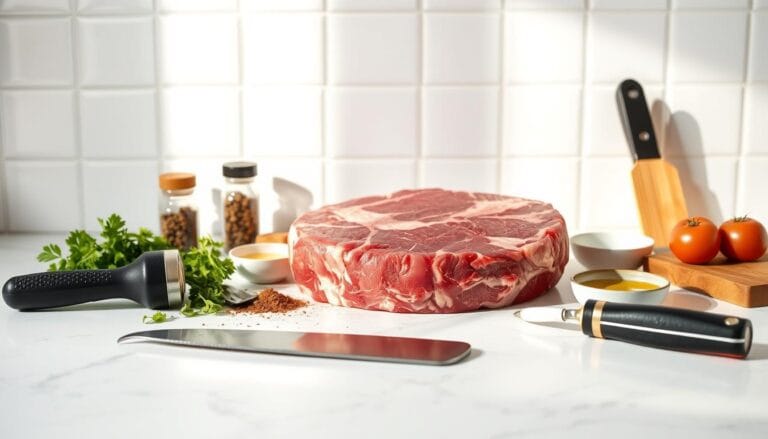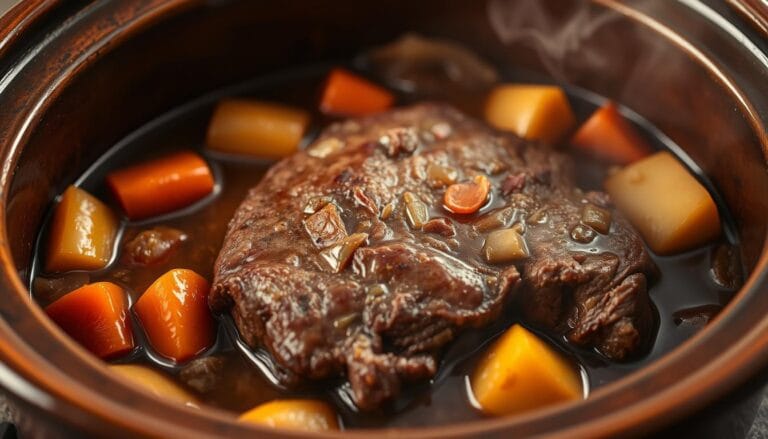How to Cook Beef Kidney: A Step-by-Step Guide
Growing up, I watched my grandmother turn a simple beef kidney into a masterpiece. The smell, the care, and the taste sparked my love for unique ingredients. Many home cooks often miss out on these gems.
Cooking beef kidney might seem scary, but it’s actually easy with the right steps. This guide will show you how to make a beef kidney dish that will wow everyone.
If you love trying new things in the kitchen, learning to cook beef kidney is a great start. You’ll discover new flavors and health benefits. We’ll cover everything from picking the best ingredients to mastering cooking techniques.
Beef kidney is not only delicious but also packed with nutrients. It only takes 2 hours and 30 minutes to prepare. You’ll make a dish that serves 4-6 people and is full of protein, iron, and vitamins.
Are you ready to learn how to make this often-forgotten ingredient into a tasty meal? Let’s start this culinary adventure together!
Table of Contents
Understanding Beef Kidney Basics
Beef kidney is a nutrient-rich organ meat often ignored in Western cooking. It’s a key ingredient in many global cuisines. This protein-rich food offers great nutritional benefits for those who dare to try it.
What Makes Beef Kidney Special
Organ meats, like beef kidney, are packed with nutrients. They offer a unique nutritional profile compared to regular muscle meats. These special dishes add distinct qualities to your meals:
- Extremely high protein content
- Rich in essential minerals like zinc and selenium
- Packed with vitamin B12
- Low in total fat
Health Benefits and Nutrition Facts
Preparing beef kidney is more than just cooking a meal. It’s a way to get a nutritional boost. The kidney is full of:
- Iron: Helps carry oxygen in the blood
- Vitamin B12: Important for nerve health and red blood cells
- Selenium: Boosts the immune system
- Protein: Helps repair and build muscles
Shopping for Quality Beef Kidney
Choosing the right beef kidney is key to a great dish. Look for fresh, vibrant kidneys without any discoloration or bad smells. Local butchers or specialty shops usually have the best quality.
Pro tip: Always choose kidneys from grass-fed, ethically raised cattle for the best flavor and nutritional value.
Essential Preparation Methods
Preparing beef kidney needs careful attention. The first step is cleaning and preparation. Mastering a few key techniques is crucial for success.
Start by cleaning the kidney well to remove impurities. The process involves several important steps:
- Remove the tough outer membrane carefully
- Trim away the white, fibrous core
- Rinse the kidney under cold water
Soaking is key in preparing beef kidney. It helps reduce the strong flavor. Experts suggest soaking for 1-2 hours in cold water with vinegar or lemon juice. This makes the meat softer and less intense.
There are different soaking methods to improve your beef kidney preparation:
- Cold salted water soak
- Milk bath technique
- Buttermilk marinade
By following these steps, you can make beef kidney delicious and nutritious. Patience and detail in cleaning and soaking are essential.
Pro tip: Always remove any visible fat and the white core for the best texture and flavor.
How to Cook Beef Kidney
Preparing beef kidney needs careful steps to make it tasty. It requires patience and special ways to cook it. This helps reduce its strong taste and makes it tender.
Cleaning and Trimming Techniques
Learning to cook beef kidney starts with cleaning it right. Here’s what to do:
- Rinse the kidney under cold water thoroughly
- Remove white membrane and connective tissue
- Trim away excess fat carefully
- Pat dry with paper towels
Soaking Process
Soaking is key to reduce beef kidney’s strong taste. Here’s how to do it:
- Soak in cold saltwater for 2 hours
- Use a milk bath as an alternative method
- Add a splash of vinegar to the soaking liquid
- Drain and rinse thoroughly before cooking
Pre-cooking Tips
Before cooking beef kidney, keep these tips in mind:
- Slice kidney into uniform pieces for even cooking
- Use medium-high heat for searing
- Cook for approximately 3-4 minutes per side
- Avoid overcooking to prevent toughness
Pro tip: The key to delicious beef kidney is patience and proper preparation!
Popular Cooking Techniques

Learning how to cook beef kidney can make it a tasty dish. It’s all about the right cooking methods. These methods bring out the meat’s flavor and texture.
Here are the most popular cooking methods for beef kidney:
- Sautéing: Quick and flavorful method that seals in nutrients
- Grilling: Creates a smoky char and crispy exterior
- Stewing: Tenderizes the meat and develops rich flavors
- Baking: Provides even, gentle cooking
- Frying: Delivers a crispy golden-brown finish
Before cooking, clean and soak your beef kidney well. Soaking in milk for 30 minutes can cut down strong flavors by up to 20%. Make sure to dry it well for the best browning and texture.
Each cooking method needs a different approach. Sautéing is best for thin slices, while stewing cooks it slowly. Grilling needs careful temperature control to avoid toughness.
Pro tip: Always slice kidneys against the grain and remove any tough membranes for the most tender results.
Classic Beef Kidney Recipes
Exploring delicious beef kidney recipes can make this unique ingredient appealing. These classic recipes will help you cook beef kidney with confidence and creativity.
Our selection of beef kidney recipes has something for everyone. Each recipe highlights the protein’s versatility and great taste.
Steak and Kidney Pie: A British Classic
This hearty recipe mixes tender meat with rich gravy in a flaky crust. It’s perfect for cold nights, offering bold flavors that will win over even the toughest critics.
- Preparation time: 15 minutes
- Cooking time: 30 minutes
- Servings: 4
- Total calories per serving: 250 kcal
Kidney in Wine Sauce: Elegant European Technique
This recipe turns beef kidney into a fancy dinner option. The wine sauce tenderizes the meat and adds depth to the dish.
- Recommended soaking time: Several hours
- Protein per serving: 21g
- Vitamin B12: 150% Daily Value
Grilled Kidney Skewers: Mediterranean Inspiration
These skewers offer a lighter way to enjoy beef kidney. Marinated and grilled, they bring a smoky flavor that showcases the kidney’s richness.
- Recommended oil for sautéing: 2 tablespoons
- Iron content: 30% Daily Value
- Zinc content: 25% Daily Value
When cooking beef kidney, remember to clean, trim, and soak it well. Try these classic recipes to find your favorite way to cook!
Best Seasonings and Flavor Combinations

Turning beef kidney into a tasty dish is all about seasoning. The right mix of spices can make this meat special. It turns your cooking into something unforgettable.
When looking into beef kidney cooking tips, think about these classic enhancers:
- Garlic powder for depth and aroma
- Freshly ground black pepper for warmth
- Smoked paprika for a subtle smokiness
- Dried thyme and rosemary for herbal notes
Creating a balanced seasoning blend is key. Start with sea salt and try different herb mixes. A good mix includes:
- 1 cup sea salt
- 1/4 cup garlic powder
- 1/4 cup dried parsley
For those who like to try new things, mustard powder or nutritional yeast can add depth. But remember, a light touch is best. It keeps the kidney’s flavor while making it more enjoyable.
Pro tip: Keep your homemade seasoning blend in an airtight container. It can last up to a year in a cool, dry spot.
Common Cooking Mistakes to Avoid
Cooking beef kidney can be tricky, even for experienced home chefs. It’s important to know the common mistakes to avoid. This way, you can make delicious, tender dishes.
When cooking beef kidney, several mistakes can ruin your dish. Let’s look at the most common problems and how to solve them. This will help you make sure your kidney dishes are always tasty.
Temperature Control Challenges
Getting the temperature right is key when cooking beef kidney. If you overcook it, it can become tough and chewy. Here are some tips to avoid this:
- Monitor heat levels carefully
- Use medium-high heat for initial searing
- Reduce temperature during final cooking stages
- Utilize meat thermometers for accuracy
Seasoning Strategies
Seasoning beef kidney needs a careful touch. Wrong seasoning can make it taste bland or too strong. Here’s how to get it right:
| Seasoning Technique | Recommended Approach |
|---|---|
| Pre-cooking Preparation | Soak in milk or salt water to reduce strong flavors |
| Spice Selection | Use robust herbs like thyme, rosemary, and black pepper |
| Marinating | Allow 30-60 minutes for flavor absorption |
Texture Transformation Techniques
To get the right texture, you need to prepare carefully. Tough, rubbery kidney can be a problem. But, with these tips, you can avoid it:
- Always trim excess membrane before cooking
- Use quick, high-heat cooking methods
- Slice kidney against the grain
- Rest meat for 5-10 minutes after cooking
By following these tips, you’ll improve your cooking skills. Your beef kidney dishes will always be tender and flavorful.
Serving Suggestions and Pairings
To make your beef kidney dishes stand out, choose the right pairings. These can turn a good dish into an amazing one.
Classic side dishes are great with beef kidney’s strong flavor. Here are some tasty options:
- Creamy mashed potatoes
- Buttered egg noodles
- Crusty sourdough bread
- Steamed green vegetables
- Fresh garden salad
Wine lovers can pair their beef kidney dishes with the right wine. Red wines with strong profiles are perfect. They cut through the meat’s bold taste.
| Wine Pairing | Flavor Profile |
|---|---|
| Cabernet Sauvignon | Bold, tannic |
| Syrah | Spicy, full-bodied |
| Malbec | Rich, smooth |
“A well-chosen side can elevate a simple beef kidney dish into a memorable culinary experience.” – Culinary Expert
For lighter meals, try pairing beef kidney with crisp sides. This balances the meat’s boldness. Try different combinations to find your favorite.
Nutritional Benefits of Beef Kidney
Beef kidney is a nutritional powerhouse that can change your cooking. It’s full of nutrients that offer great health benefits. Every bite of your beef kidney dishes is a step towards better health.
Beef kidney is a great choice for your diet. A three-ounce serving has a lot to offer:
- 15 grams of high-quality protein
- Only 112 calories
- 2.5 grams of fat
- 23 micrograms of Vitamin B12
- 3.9 milligrams of iron (20% of daily recommended intake)
The mineral content in beef kidney is amazing. Kidney meat contains 119 micrograms of selenium and 222 milligrams of potassium. These support immune health and muscle performance.
“Organ meats can provide up to 100 times more concentrated and bioavailable nutrients than muscle meat” – Nutritional Research
Your body will thank you for the zinc in beef kidney. It has 1.6 milligrams per serving. This supports immune function and metabolic processes. Beef kidney is also good for low-carb and ketogenic diets.
Adding beef kidney to your diet boosts your nutritional intake. It’s a natural source of vitamins and minerals that support health.
Storing and Preserving Beef Kidney
Storing beef kidney right is key to keeping it fresh and safe. Fresh beef kidney needs careful handling to keep its nutrients and prevent spoilage. Knowing how to store it well can extend its shelf life.
Here are important tips for storing beef kidney:
- Refrigerate immediately after purchase
- Store at temperatures below 40°F (4°C)
- Use within 1-2 days of buying
- Keep in an airtight container
Freezing is a great way to keep beef kidney longer. Wrap the beef kidney tightly in freezer-safe packaging to avoid freezer burn. If done right, frozen beef kidney stays good for 3-4 months.
Here’s how to freeze beef kidney:
- Clean the kidney thoroughly
- Pat dry with paper towels
- Wrap in plastic wrap or freezer paper
- Place in a sealed freezer bag
- Label with the date of freezing
Always check for spoilage before cooking. Fresh beef kidney should be deep red and have a mild smell. If it smells strong or feels slimy, it’s bad and should be thrown away.
Pro tip: When thawing frozen beef kidney, always do so in the refrigerator to maintain food safety and prevent bacterial growth.
Conclusion: Mastering the Art of Cooking Beef Kidney
Learning to cook beef kidney opens up new culinary adventures for home cooks. You’ll discover its unique flavor and learn key cooking techniques. These skills turn this organ meat into a tasty dish.
Cooking beef kidney is about patience, preparation, and the right seasonings. By using what you’ve learned, you can make beef kidney a tasty and nutritious part of your meals. Don’t be afraid to try new flavors and cooking ways.
Your success with beef kidney comes from choosing well, cleaning thoroughly, and cooking just right. Whether making a traditional steak and kidney pie or trying new recipes, your skills will grow. You’ll cook with confidence and creativity.
Cooking is a journey of learning. Every time you cook beef kidney, you’ll get better and appreciate its nutritional value more. Your cooking skills will improve, making this challenging ingredient a joy to cook with.







